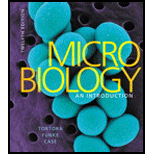
Microbiology: An Introduction
12th Edition
ISBN: 9780321929150
Author: Gerard J. Tortora, Berdell R. Funke, Christine L. Case
Publisher: PEARSON
expand_more
expand_more
format_list_bulleted
Concept explainers
Question
Chapter 16, Problem 2CAE
Summary Introduction
Case summary:
Hematologist makes an analysis on the differential white blood cell count of a patient blood sample. He determines the relative or decreased number of white blood cells in the blood sample.
Expert Solution & Answer
Want to see the full answer?
Check out a sample textbook solution
Students have asked these similar questions
What is the structure and function of Eukaryotic cells, including their organelles? How are Eukaryotic cells different than Prokaryotic cells, in terms of evolution which form of the cell might have came first? How do Eukaryotic cells become malignant (cancerous)?
What are the roles of DNA and proteins inside of the cell? What are the building blocks or molecular components of the DNA and proteins? How are proteins produced within the cell? What connection is there between DNA, proteins, and the cell cycle? What is the relationship between DNA, proteins, and Cancer?
Why cells go through various types of cell division and how eukaryotic cells control cell growth through the cell cycle control system?
Chapter 16 Solutions
Microbiology: An Introduction
Ch. 16 - Identify at least one physical and one chemical...Ch. 16 - Define inflammation, and list its characteristics.Ch. 16 - What are interferons? Discuss their roles in...Ch. 16 - How can the complement system cause endotoxic...Ch. 16 - Patients with X-linked chronic granulomatous...Ch. 16 - Prob. 6RCh. 16 - Give several examples of how microbes evade the...Ch. 16 - Prob. 8RCh. 16 - Are the following involved in innate or adaptive...Ch. 16 - These agranulocytes are not phagocytic until they...
Ch. 16 - Prob. 1MCQCh. 16 - Prob. 2MCQCh. 16 - If the following are placed in the order of...Ch. 16 - Prob. 4MCQCh. 16 - A human host can prevent a pathogen from getting...Ch. 16 - Prob. 6MCQCh. 16 - In 1884. Elie Metchnikoff observed blood cells...Ch. 16 - Prob. 8MCQCh. 16 - Prob. 9MCQCh. 16 - Prob. 10MCQCh. 16 - Prob. 1ACh. 16 - Prob. 2ACh. 16 - Prob. 3ACh. 16 - The list below identifies a virulence factor for a...Ch. 16 - People with Rhinovirus infections of the nose and...Ch. 16 - Prob. 2CAECh. 16 - Leukocyte adherence deficiency (LAD) is an...Ch. 16 - The neutrophils of individuals with Chdiak-Higashi...Ch. 16 - Consider the following. a. In laboratory...
Knowledge Booster
Learn more about
Need a deep-dive on the concept behind this application? Look no further. Learn more about this topic, biology and related others by exploring similar questions and additional content below.Similar questions
- In one paragraph show how atoms and they're structure are related to the structure of dna and proteins. Talk about what atoms are. what they're made of, why chemical bonding is important to DNA?arrow_forwardWhat are the structure and properties of atoms and chemical bonds (especially how they relate to DNA and proteins).arrow_forwardThe Sentinel Cell: Nature’s Answer to Cancer?arrow_forward
- Molecular Biology Question You are working to characterize a novel protein in mice. Analysis shows that high levels of the primary transcript that codes for this protein are found in tissue from the brain, muscle, liver, and pancreas. However, an antibody that recognizes the C-terminal portion of the protein indicates that the protein is present in brain, muscle, and liver, but not in the pancreas. What is the most likely explanation for this result?arrow_forwardMolecular Biology Explain/discuss how “slow stop” and “quick/fast stop” mutants wereused to identify different protein involved in DNA replication in E. coli.arrow_forwardMolecular Biology Question A gene that codes for a protein was removed from a eukaryotic cell and inserted into a prokaryotic cell. Although the gene was successfully transcribed and translated, it produced a different protein than it produced in the eukaryotic cell. What is the most likely explanation?arrow_forward
- Molecular Biology LIST three characteristics of origins of replicationarrow_forwardMolecular Biology Question Please help. Thank you For E coli DNA polymerase III, give the structure and function of the b-clamp sub-complex. Describe how the structure of this sub-complex is important for it’s function.arrow_forwardMolecular Biology LIST three characteristics of DNA Polymerasesarrow_forward
arrow_back_ios
SEE MORE QUESTIONS
arrow_forward_ios
Recommended textbooks for you
 Human Biology (MindTap Course List)BiologyISBN:9781305112100Author:Cecie Starr, Beverly McMillanPublisher:Cengage Learning
Human Biology (MindTap Course List)BiologyISBN:9781305112100Author:Cecie Starr, Beverly McMillanPublisher:Cengage Learning Human Physiology: From Cells to Systems (MindTap ...BiologyISBN:9781285866932Author:Lauralee SherwoodPublisher:Cengage Learning
Human Physiology: From Cells to Systems (MindTap ...BiologyISBN:9781285866932Author:Lauralee SherwoodPublisher:Cengage Learning


Human Biology (MindTap Course List)
Biology
ISBN:9781305112100
Author:Cecie Starr, Beverly McMillan
Publisher:Cengage Learning

Human Physiology: From Cells to Systems (MindTap ...
Biology
ISBN:9781285866932
Author:Lauralee Sherwood
Publisher:Cengage Learning


